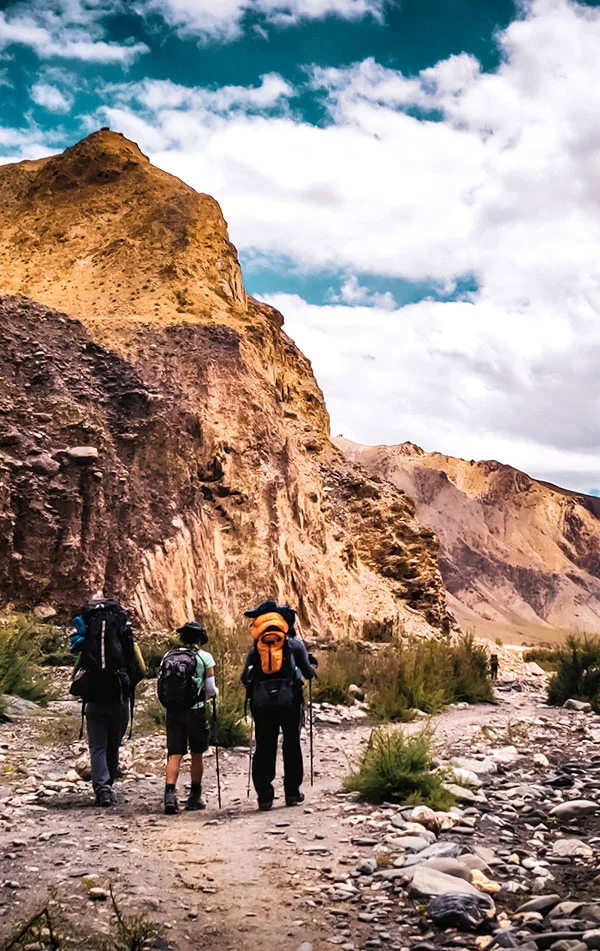
Region
Ladakh | India
Duration
7 Days
Max Altitude
17100 Ft.
Trekking Km
61 KM
Grade
Moderate
Help & Support
+91 8191004846 info@trekthehimalayas.com10:00 hrs to 18:00 hrs | GMT +5:30
Monday - Saturday | Sunday Closed
22500 /Person
- May-2024
- June-2024
- July-2024
- August-2024
- September-2024
- +5% GST (goods and services tax)
- Services Leh to Leh | Included Transport
- Addons
-
Backpack offload is optional
-
Choose add-ons during booking. If missed, log in and add them later.
-
Book off-load at least 10 days before the trek.
-
For offline bookings at the base camp, a convenience fee of Rs. 4500 applies.
-
Cancellations made before the trip date will receive a full refund.
Offload 4200
For more information. Please complete this form.
Help & Support
+91 991 772 4737info@trekthehimalayas.com 10:00 hrs to 18:00 hrs | GMT +5:30
Monday - Saturday | Sunday Closed
Overview
Trek Name: Markha Valley Trek
Days: 7
Adventure Type: Trekking
Base Camp: Leh
Season:Summer | Monsoon | Autumn |
Month:April | May | June | July | August | September | October | November |
Country: India
Altitude: 17100 Ft.
Grade: Moderate
Rail Head: Manali is the nearest rail head to the base camp
Stay: Camping (Twin sharing) & Hotel/Guesthouse
Food: Meals while on trek (Veg + Egg)
Location: Ladakh
Distance: 61 Km.
Trail Type: Cross over trail | Start in one valley, traverse the pass, and ends in another valley.
AirPort: Leh (Kushok Bakula Rimpochee)
Highlights:
- +5% GST (goods and services tax)
- Services Leh to Leh | Included Transport
Located in the northern part of India, the union territory of Ladakh lies in the westernmost part of the Himalayas in the close vicinity of the Karakoram Ranges. The capital of Ladakh, Leh, the most desired adventure hub, is popular for its raw and arid thrill and a gateway to burned-out trails. With the Markha Valley trek, one gets to rediscover the parched region of the mighty Himalayas. The mysterious ride of 8 days, exhibiting lush green to yellow barren landscapes, passing alongside the Indus River will be borne in your mind for a lifetime.
Markha Valley is the largest valley in the region. Of course, Leh is the starting point of this trek, which is an added advantage to exploring the Buddhist monuments in Leh. You will be astonished to traverse through the tiny hamlets as you gain altitude. Surprisingly, these villages host cafes or tea houses serving to rejuvenate hot drinks when you are tired from the strenuous hike. One after another, Rumbak, Yurutse, Skiu, Markha, Hankar, and Nimaling settlements will revitalize you. Not only that, most of the villages have preserved monasteries, ruined forts, and temples. Amongst them, the Tacha monastery is an eye and heart catcher that lies between the mountains.
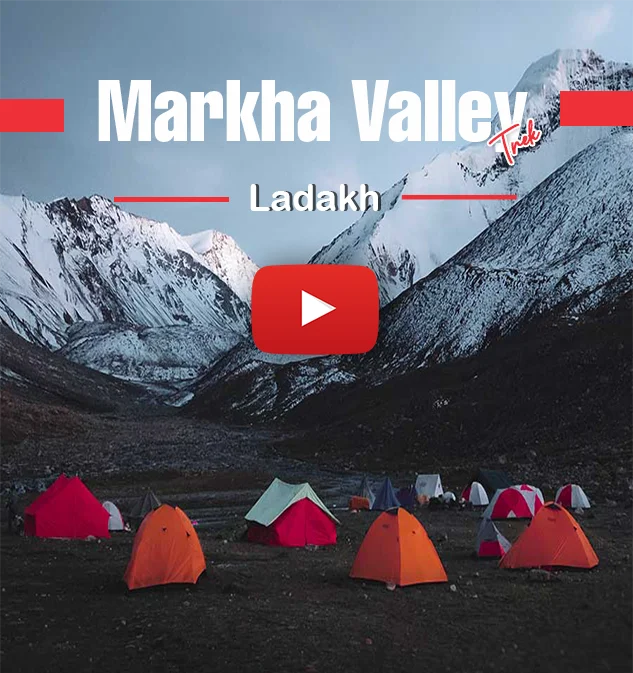
Who Can Participate
-
Age; 15 years.
-
Experience of any high altitude trek, at least 1 treks of 4,000m/13,100ft.
-
The climber must be fit and have sufficient stamina to cover 5 km of distance in 30 minutes without stress.
-
The climber should be able to carry a 12-16 kg backpack.
-
Pulse rate at rest must be in between (60 to 90 beats per minute)
-
Blood Pressure Reading must be in between (DIASTOLIC 70 – 90, SYSTOLIC 100 - 140 mm Hg)
-
Respiratory rate at rest must be in between (12 to 20 breaths per minute)
-
Should not have Liver and kidney issues
-
Should not have Diabetes Mellitus, Bronchial Asthma, Heart problems, Hypertension etc
-
No pacemaker implant
-
People with the Sinus issues, Epilepsy please contact to trek coordinator before booking the trek
-
If your BMI is not normal, Please contact our Trek coordinator before Trek booking.
Medical & Disclaimer Form (Mandatory Documents) Click here to download Medical & Disclaimer Form
- Government Employees can avail the benefit of Special Casual Leave (SCL) when you join us for a trekking expedition. As per the rules of the Pay Commission, Special Casual Leave can be availed for up to 30 days in a calendar year for trekking/mountaineering expeditions through a registered organization. Trek The Himalayas is a registered adventure tour operator by Indian Mountaineering Foundation (IMF) and Ministry Of Tourism (MOT)
- Trekkers have to apply for leave at least 20 days before trek departure date,
- This service is exclusive to Indian government employees and is applicable only for treks within India.
- Do mail at info@trekthehimalayas to apply and mention your booked trek date and trek name.
- Junior trekkers (below 15 years) should have a company of parents/guardians.
- Trekkers between 15 to 18 years can come solo with the disclaimer form signed by parent/guardian.
- Medical & Disclaimer Form (Mandatory Documents) Click here to download Medical & Disclaimer Form
Itinerary
Arrival in Leh
Markha Valley trek begins from Leh. Arrive in Leh by flight or train. Take it slowly once you arrive in Leh. Since it is at the hazardous height of 11,000 ft direct landing at this height may trigger AMS. Make sure you rest well and do not strain your body during your stay in the hotel. Leh has gained popularity as the adventure capital of India. It is quite famous amongst wanderers, which you can evidently see as you roam here and there.
Cafes are loaded here which are hanging out places for adventurers. There is a good network connection in Leh and has ATMs. Leh is a good option to fill up your things to carry list if you have forgotten any item. Although cafes are in close vicinity, try to stay away from alcohol and avoid smoking. Apart from that, Leh is also known for monasteries, palaces, and temples. Make sure to visit them as you enjoy your small treat in Leh. You can also explore the local market in Leh and try the local cuisine. Staying outdoors will help you acclimatize to the altitude. Reserve the evening for rest. Sleep well and let your body acclimatize to the altitude.
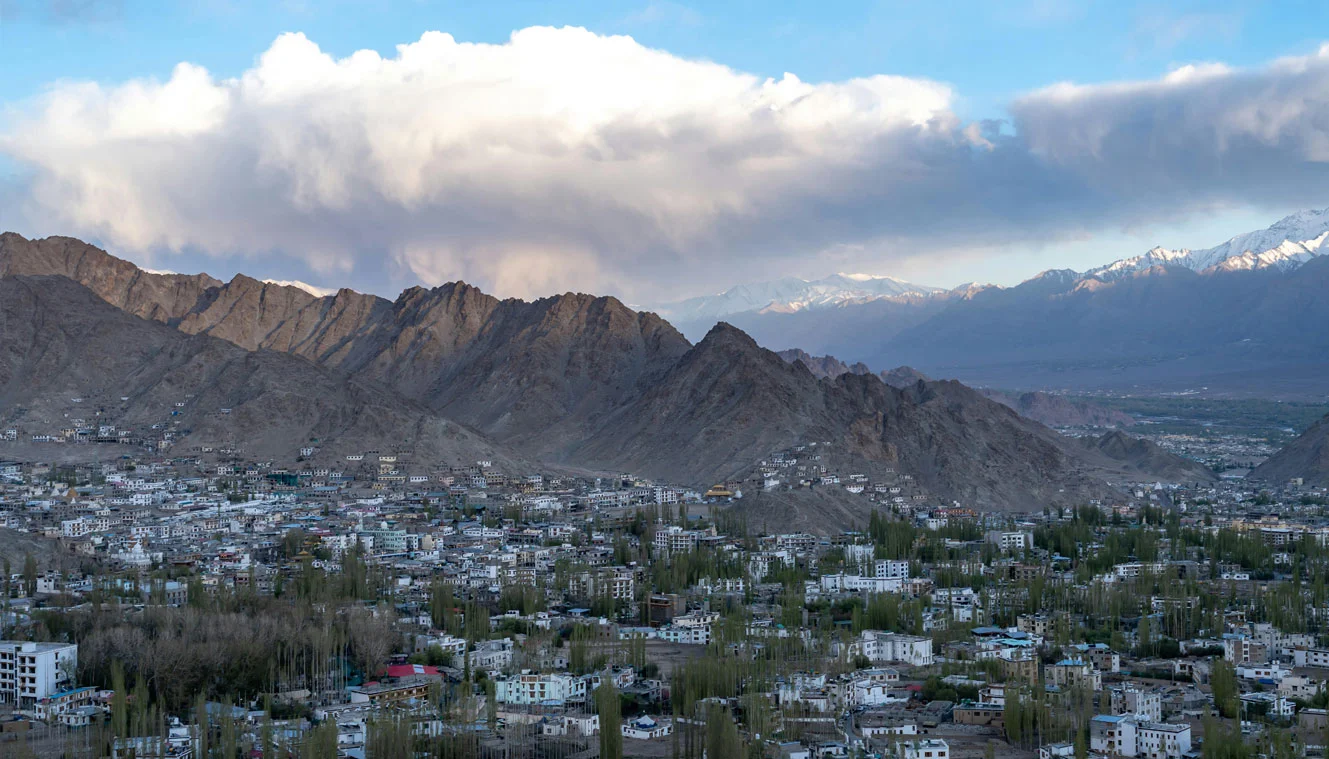
Acclimatization in Leh
This is an extra day added to the itinerary to help you get acclimatized better. Therefore utilize this day and try to stay outdoors. Acclimatization days in our treks are used to give your body time to adjust to the thinning air at high-altitude conditions. Several changes occur in your body while trekking in high-altitude regions and the purpose of acclimatization is to allow your body to operate optimally in a decreased oxygen level environment.
Leh is a major hub for adventure as well as a culturally rich center. It presents innumerable opportunities for sightseeing starting from the monasteries and temples, the local market as well as many places serving delicious local cuisine. Today, you can hike up to the Shey Palace, Thiksey Monastery, and Thiksey Gompa to experience the Buddhist culture. Thiksey Gompa is the largest in central Ladakh, located on a hill. Avoid gaining height by hiking to nearby passes or valleys. This is only to avoid stressing your body, as it may hinder the process of acclimatization.
Additionally, you can interact with the locals and fellow travellers to gain some knowledge about the adjacent areas. Roam in the Leh city and the Leh Bazaar. You can collect souvenirs from a variety of shops. You must spend the sunset at the Shanti Stupa, which is known for its dazzling lights in the evening. Say goodbye to the wonderful Leh and rest in your hotel. Your actual trekking day begins tomorrow.
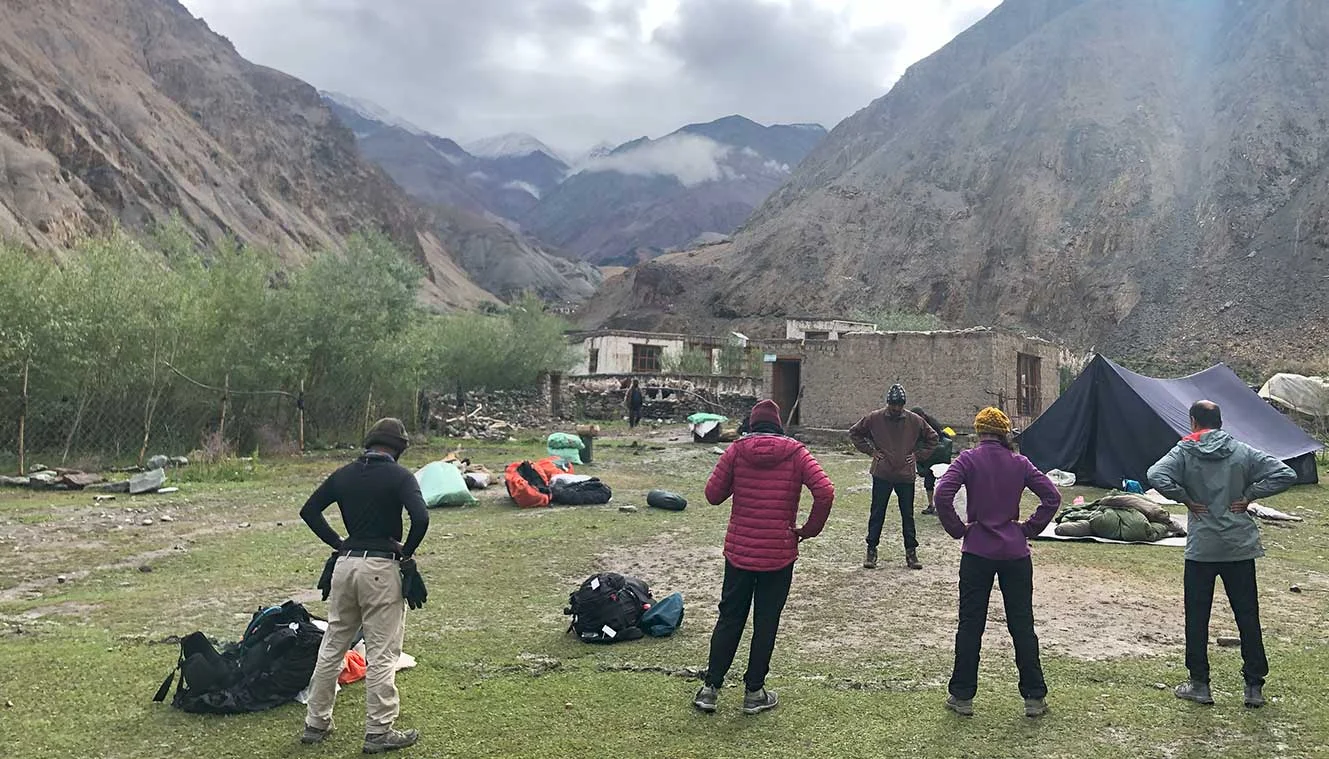
Drive From Leh To Chilling And Trek To Skiu
Get set as your real trek journey commences. You will be riding along the skillfully paved roadways crossing marvellous landscapes. Throughout the road, you will encounter military camps decorated with colorful big rocks around the camps. Do not miss Gurudwara Pathar Sahib on the right and Magnet Hill on the left as you move ahead. The Stok Range remains on the right until it vanishes slowly when you reach Hemis National Park. You will be pleasantly surprised once you reach Sangam. Indus and Zanskar rivers, both bottle green, yet so unique, form the most spectacular confluence. This point is also famous as starting end for rafting. Take a diversion here towards Chilling. The surrounding view henceforth changes magically. The open terrain beside the road enters into the closed valley. Valley has stunning purple, black, and grey shades of the mountains. Juniper and tall alpine trees will border the route as you cross the Zanskar river over green iron bridges. Take a deep breath once you get down at Chilling, as the walking will begin in a few minutes. Chilling is the point where the Markha River merges into Zanskar.
The trek ahead incepts a steep ascent going through Zingchen Gorge. Amidst you will also cross the river on a trolley at Kaya-Do place. The trail many times comes across the river. Skiu will mark the first camping in the tents. It is located at the confluence of rivers Shgri Nala and Markha. Skiu village is largely divided into two sections, upper and lower village. Lower Skiu has 12 houses quite close to each other. A small trudge, old monastery, and ruins of a palace separate it from upper Skiu. There are small white stupas and mani stones laid towards upper Skiu. Markha River lies on the right of the village.
Most of the places here offer homestays. Relax after a mini-trek, while looking forward to the upcoming trek.
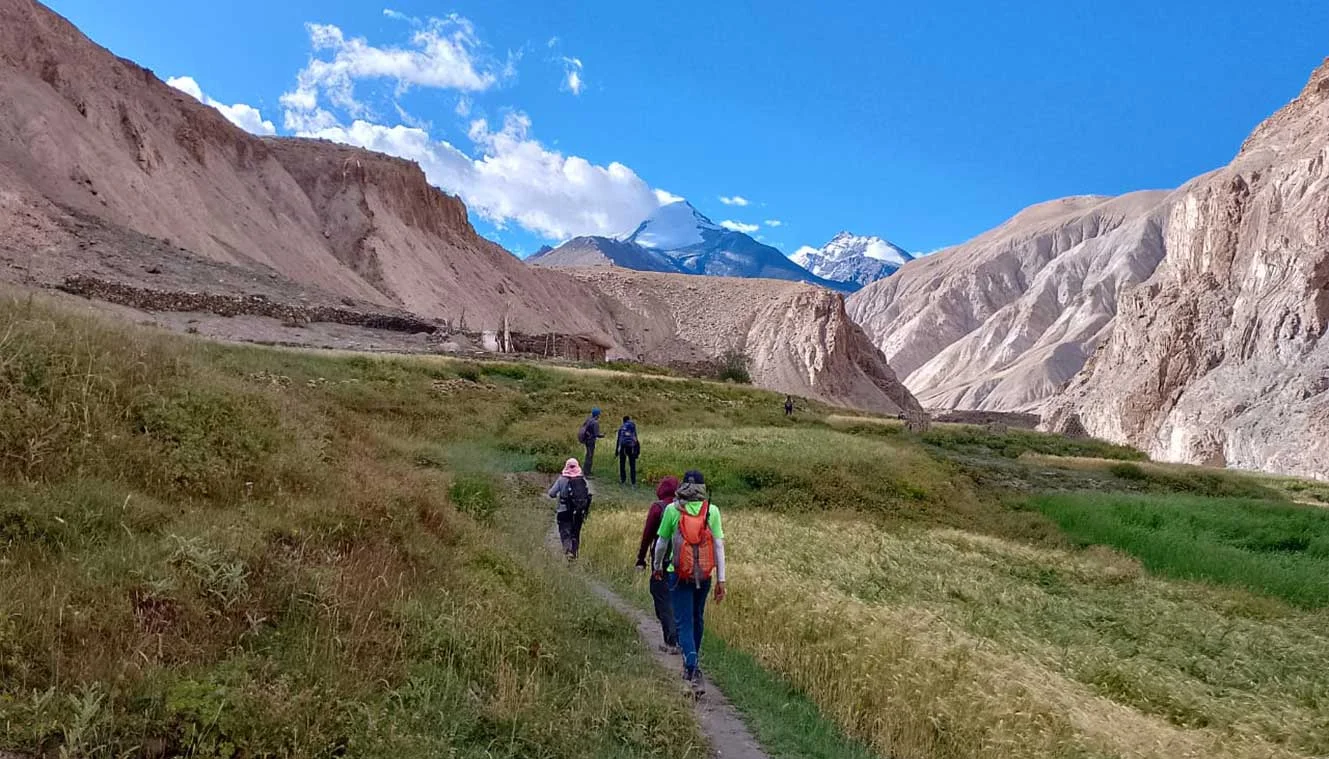
Skiu To Markha
Start fresh for the actual first trekking day. Be vigilant about birds and animals. Markha valley harbors enormous wildlife. Magpie birds will be visible right after you step out of the house. The trail is quite evident and well-paved intermittently. The Markha River will remain escorting on the right, which incepts from Kang Yatse peaks. In an hour a cafe can be spotted, take a small break here and keep walking. The trail is enclosed by the valley that goes through sparse forest cover. After another hour’s trudge and the first wooden bridge comes to Zanpa Yoakma.
In about 25 minutes another coffee shop at Hamourja is waiting for you to rejuvenate. You will cross the Markha River a couple of times during the trek as you pass through various winter settlements containing Lhatos (religious shrines built for the local deities) as well as Mani walls (walls made of stone inscribed with prayers). Look out for black sheep, deer, and mountain goats on these banks. Keep walking straight to Nagding village for another 40 minutes. Right in front of the houses spot meditation caves at a height on the valley walls. These caves are believed to be having paintings from the 20th century. The banks of the Markha River get wider and you can find yourself stepping in the powdered sand. Enjoy the feeling of Himalayan sands.
After about 1 hour from Nagding village, a big entrance of Sara village appears. The entrance is decorated with skeletons of wild animals. Unlike Skui, Sara seems like an open area. Sara Village is also home to a monastery and ruins of an old castle which is believed to be the resting spot of the Royal families on their way to Srinagar in ancient times. You may also see wheat plantations and Bushoi (a cotton-like flowering plant and also a natural painkiller). Also, a unique thing that you will notice is that the entrance to Sara village is decorated with skulls of animals like Yak or Sheep. These animal skulls are perceived as a sign of pride for the locals.
From here, the first tea houses arrive immediately after 30 minutes at Chalak village. The Chalak Village comes after crossing a wooden bridge. The village has houses placed on small hills with stone protection shelters for domestic animals at the base. Visit any of the villagers and they will greet you with Namkin Chai and biscuits. Re-energize with affectionate talks and hot drinks. You will see Barley fields in the village. From Chalak, it is a gradual ascent up towards Markha and you will pass by the section of the trail marked by Bharal horns. The destination is 2 hours away from here.
At every small distance, you can find Mani stones laid around white stupas. These stones are engraved with Buddhist prayers, some of them in the Sanskrit language too. Be humble in front of these historic symbols. Do not dare to touch these stones. The villagers believe these stones are protected by some powers, and any harm to them will cause harm to that person. Do not forget to notice the ruins of the palace at every turn in the valley. This can be figured out by flags at a height on small temples. These palaces were considered viewpoints and signalling points during the reign of the Kings. Markha Village is considered the largest village, you can find numerous houses, scattered away. You will have to walk in the running stream of the Markha River to reach the Markha village. The water in the Markha River can be thigh-high at some points, so it is better to take off your shoes and socks and pull up your pants to cross the river. The cold water will bring back all the energy. In 20 minutes, you can see the hamlet. Markha is the biggest village in the entire valley and comprises 25 houses.
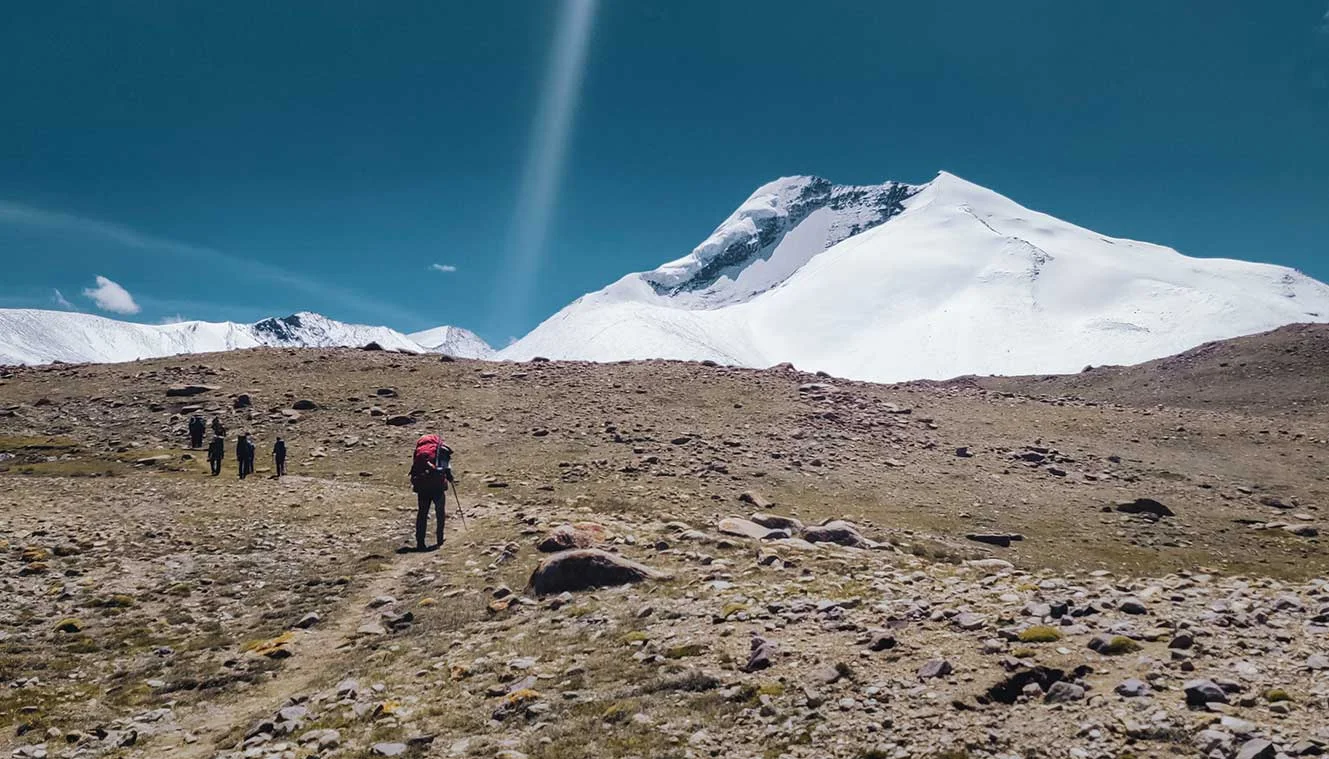
Markha To Hankar
Take the most advantage of the innocence of the salient villages because today will probably be the last habitats on the route. Today is one of the most beautiful days of trekking and the views start opening up as you traverse the upper Markha Valley. The trail is beautiful and refreshing when it merges with flowing rivers and streams. These water bodies can also be crossed over a bridge. Umlung village is a small village and will serve as the last teahouse of the trek with yet another serene monastery to your sight.
After Umlung you can get the first sight of Mt. Kang Yatse(6400m). It seems as if the peak is calling you! Follow its voice, again overcome the river several times and enter the Hankar village. Try to spot the magically placed Tacha monastery on a mountain. It is the last hamlet of the trek and your refuge place.
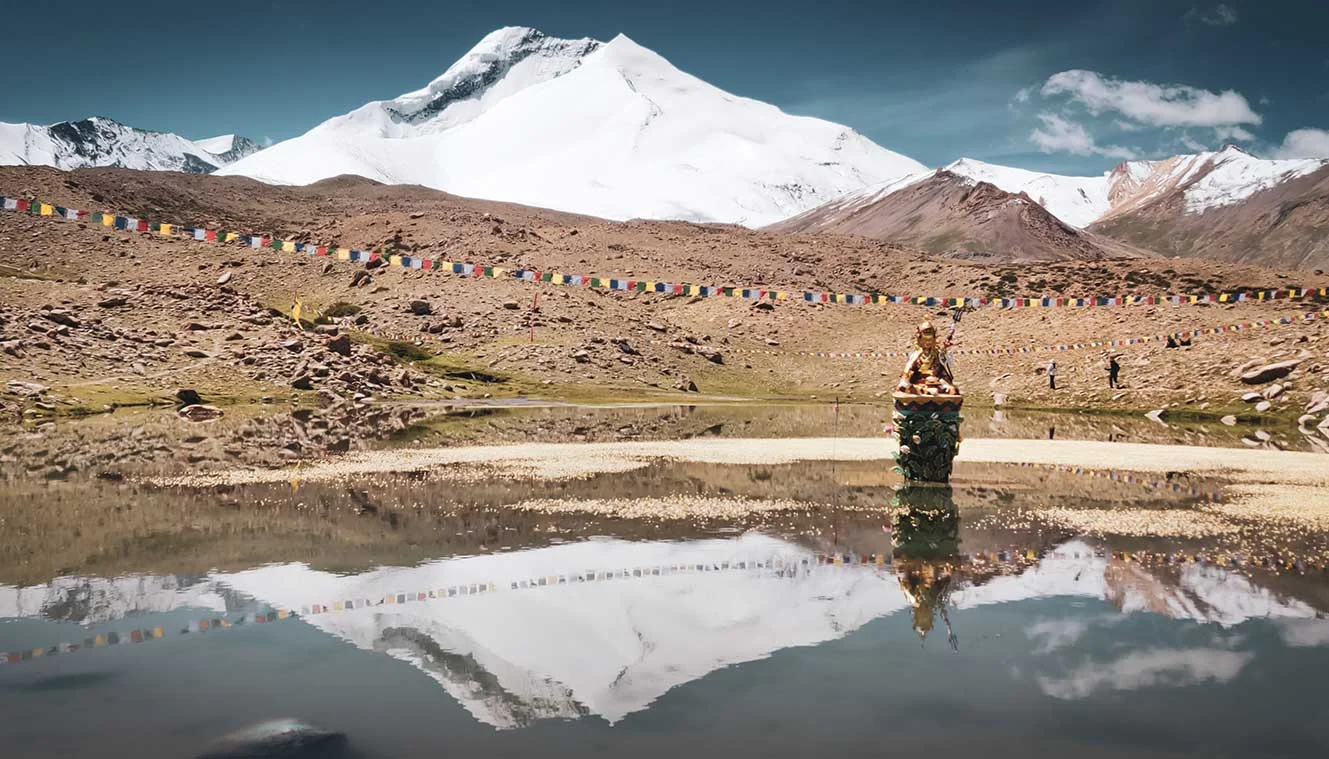
Hankar To Nimaling
Get all enthusiastic, after yesterday’s tough trek, today will be an easy and short trek. Start walking and in 1 km you will find diversions or paths separating out. The other route goes to Rupshu and Zanskar. Keep walking on the left path until a stone bridge. This marks that you are on the right trail. Henceforth, you can see many diversions, please be careful and follow the trek leader/guide. In the next 2 hours, the pastures of Thochuntse become visible. There camping sites and tea houses here. Thochnugtse also has some lovely green fields which are quite a contrast to the aridness of the desert in Ladakh. Keep walking slowly, enjoying the view. The trail is quite steep for like an hour after which becomes a gradual incline.
Try to engulf yourself in nature and move slowly just as you focus on the Kang Yatse peak. The peak seems to grow bigger and bigger. Surprisingly, tranquil twin lakes also come along the path. From the lakes, it is a long and gradual descent to the plateau of Nimaling. The trails enter into a huge grassland after a few fights crossing streams of the high altitudes. Sheep, mountain goats, and sometimes rabbits are found grazing at Nimaling. It is a pleasant camping place. It is the highest point you will attain on this trek and being the highest campsite Nimalaing offers spectacular views of the Kang Yatse Peak on the right. There are instances of snowfall at this site hence we prepared for that. Above all that, just try to merge into the high world and sleep in peace.
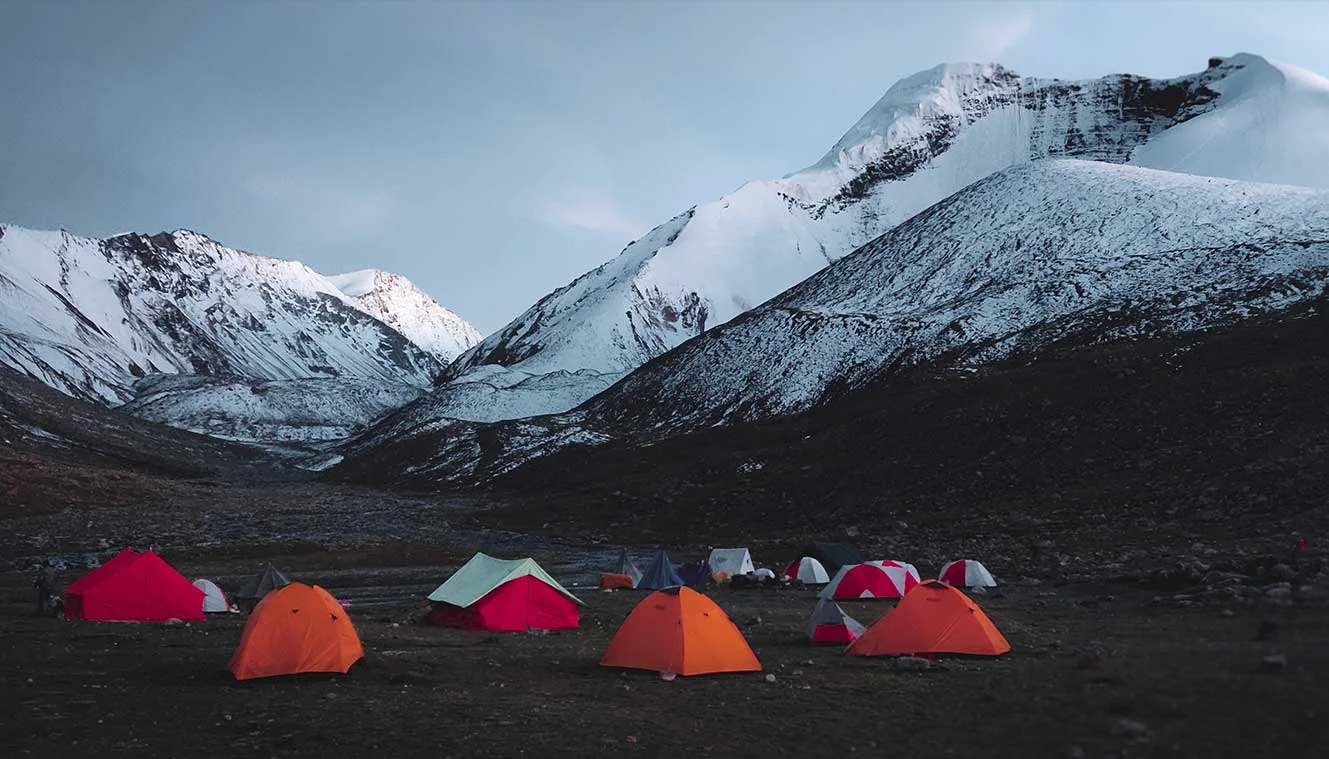
Nimaling To Chokdo via Kongmaru La And Drive To Leh
This day will be nostalgic and exciting, as this is the last day of the trek landing at the highest pass of the trek. Kongmaru La is visible distinctly from Nimaling on your left. Also, this day will be filled with surprises. Cross the stream near the campsite and then you will have to follow the clear trail to reach the pass. After a strenuous climb of 2 hours to Kongmaru La pass, you will be pleasantly welcomed by the Karakoram Range Mountains and the excellent array of peaks. Hold your breath for the mind-blowing sight of the huge K2 Mountain, the second-highest peak in the world. There are prayer flags moving along the wind. To your surprise, there is a good network connection from the pass.
The trail then gradually descends, coinciding with villages to say goodbye. The immediate trail from the pass has a steep and narrow descent which later opens to Chikirmo village. The descent can be pretty hard on your knees as it is quite steep. Throughout the route, you can get indulged in the scenery of the Indus Valley and the Ladakh range. After a gradual climb down and rocky terrain, you will reach Chokdo. This is the last stop of the entire trek, which also has many homestays. Get into the pickup vehicle that will take you to Leh.
Take a sigh of relief in this village, as your next stop will be the last stop, Leh. The further road is descending showing the monastery and Hemis Gompa. Fill them in your eyes, heart, and mind. Close your eyes to rewind the entire Markha Valley diaries.
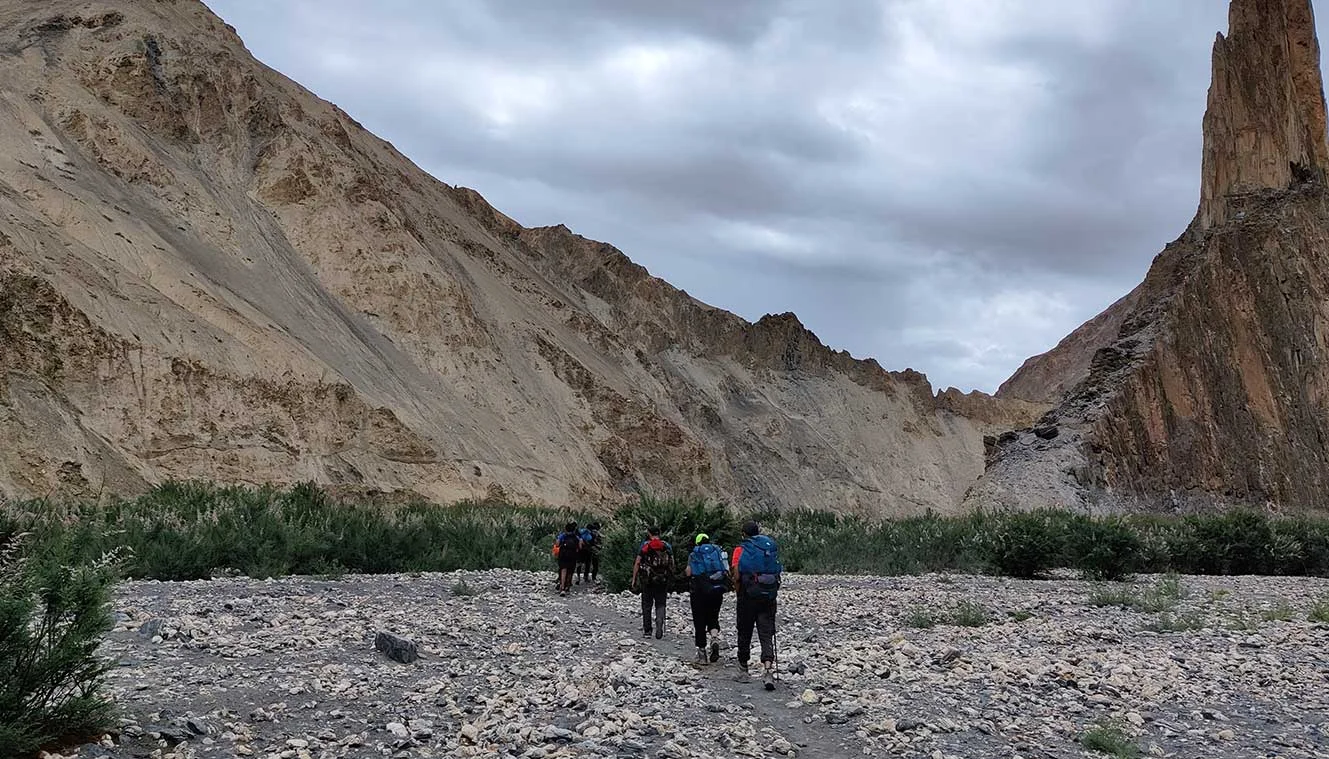
Day-1: Arrival in Leh
- Altitude:- 3,500 m/11,500 ft.
- Check-in Hotel.
- Briefing about the trek at 5 pm (mandatory).
- Bring a copy of ID proof and 2 photographs foreigner, a copy of passport and visa.
- The network is available (only post-paid).
- ATM is available.
- Can purchase or rent trekking equipment from Leh.
- A visit to any very high altitude place or pass is not advisable.
- Consumption of alcohol and smoking is strictly prohibited.
- Stay in hotel.
NOTE: Markha Valley Trek is of 7 days and the highest altitude is of 17,100 ft. If you are looking for more challenging adventure in Leh try out the Twin Peaks Expedition. You can go for either Kang Yatse II or Dzo Jongo Peak as well.
Day-2: Acclimatization in Leh
- Acclimatization and sightseeing in Leh.
- Can visit monasteries: Shey, Thiksey, Sangam, and Hemis.
- Avoid river rafting, you can plan it after your trek.
- A visit to any high-altitude place or pass is not recommended.
- Stay in hotel.
Note: Downhill cycling tour around Leh without straining body.
Day-3: Drive From Leh To Chilling And Trek To Skiu
- Altitude: Chilling - 3,200 m/ 10,500 ft; Skiu - 3,400 m/ 11,150 ft.
- Drive Distance: 65 km | Duration: 2 to 3 hrs (Leh to Chilling).
- Trek Distance: 9 km | Duration: 4 to 5 hrs (Chilling to Skiu).
- Altitude Loss: 100 m/ 350 ft.
- Drive through Gurudwara Patthar Sahib, Magnetic Hill, and the confluence of Indus and Zanskar.
- Accommodation in homestay/ camping.
Day-4: Skiu To Markha
- Altitude: 3,700 m/ 12,200 ft.
- Trek Distance: 16 km | Duration: 7 to 8 hrs
- Altitude Gain: 500 m/ 1050 ft.
- Longest day but normal and plain slope.
- Markha is one of the largest villages in the valley
- Cafes on the way.
- 2-3 river crossing.
- Monastery and palace visit at Markha.
Day-5: Markha To Hankar
- Altitude: 4,100m/ 13,400 ft.
- Trek Distance: 13 km | Duration: 8 to 9 hrs.
- Altitude Gain: 400m/ 1200 ft.
- Teahouse at Umling Village.
- Last Village Of The Valley.
- View Of A Beautiful Monastery.
- The path will intersect the River a number of times.
- After Umlung, you will have the first look at Mt. Kang Yatse (6,400 m).
- Packed lunch on the way.
- Accommodation in homestay/ camping.
Day-6: Hankar To Nimaling
- Altitude: 4,800 m/ 15,800 ft
- Trek Distance: 7 km Duration: 3 to 4 hrs.
- Altitude Gain: 700 m/ 2,400 ft.
- An easy trek.
- Amazing view of Kang Yatse.
- Amazing view of Tigu Lakes.
- Packed lunch on the way.
- Accommodation in tent.
Day-7: Nimaling To Chokdo via Kongmaru La And Drive To Leh
- Altitude: Kong Maru La - 5,200 m/ 17,100 ft; Chokdo - 3,700 m/ 12,100 ft
- Trek Distance: 16 km | Duration: 7 to 8 hrs
- Descent to Chokdo (Shang Valley) from Kongmaru La is a little long.
- The highest altitude pass crossing along the trek makes it a difficult day.
- Cross a stream terrain and proceed to the north.
- It will take 2 to 3 hrs of a hike for Kongmaru La Pass.
- Amazing views of Indus and Ladakh Range.
- A steep descent and rocky terrain.
- From Chokdo drive to Leh (2 hrs drive).
- Packed lunch on the way.
- Accommodation in hotel.
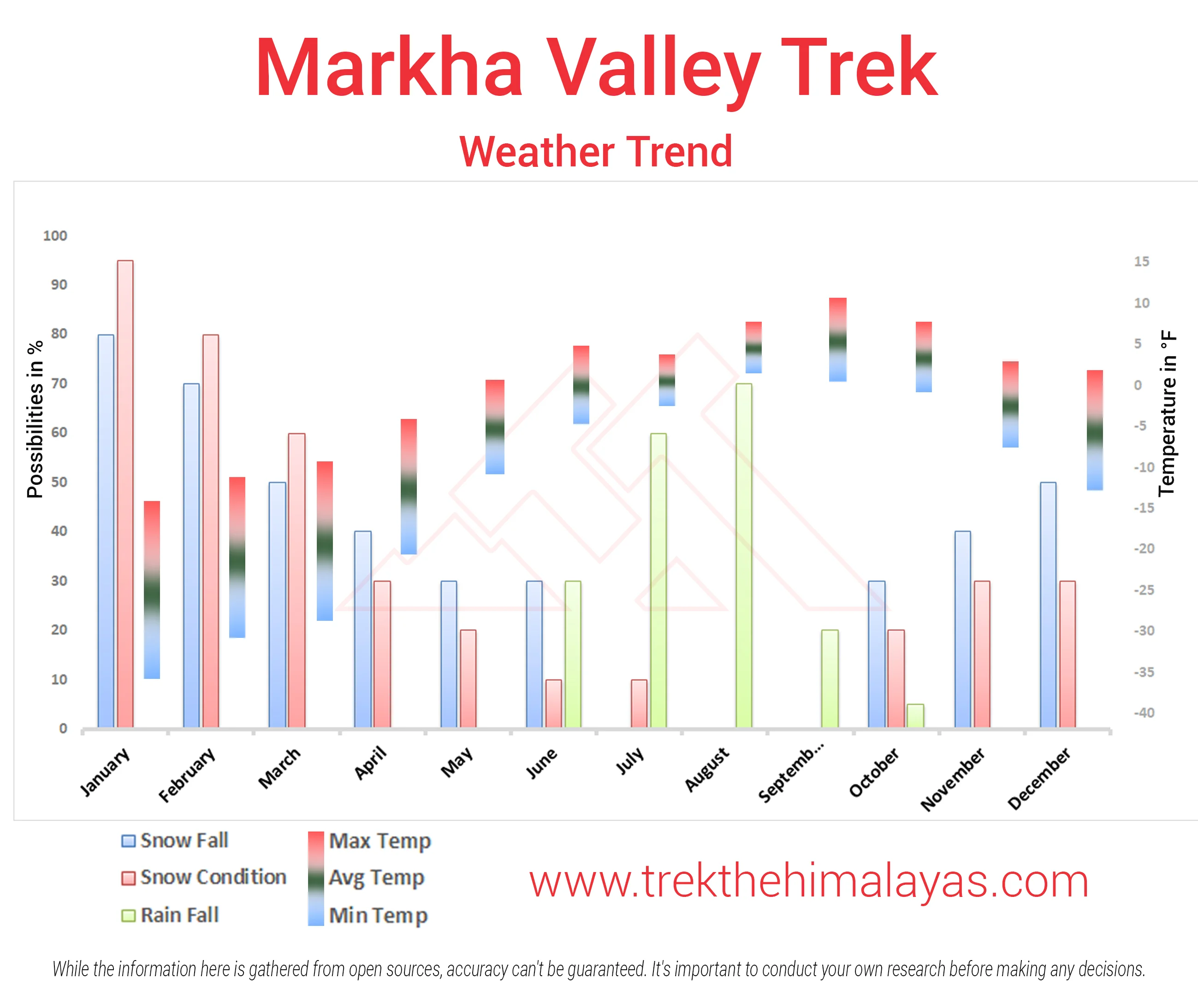
Important Links
Medical & Disclaimer Form (Mandatory Documents) Click Here.
How To Reach
It is essential for everyone to arrive at Leh (01:00 am)
Upon booking the trek, your trek coordinator will furnish you with the hotel details.
Choose any option to reach Leh
-
The easiest and best way to travel is to fly to Kushok Bakula Rimpochi Airport located in Leh. It is just 4 km away from the main city. The airport is well connected to Delhi and also receives flights from Mumbai, Srinagar, Jammu, Chandigarh and other general destinations in India. Even international travellers can fly directly from major cities like Kolkata, Mumbai and Delhi. You can find taxis outside the airport or book a cab to reach the required destination.
-
There are two road routes to Leh
-
Manali (Himachal Pradesh ) to Leh via Baralacha La, Lachulung La and Tanglang La and It covers a distance of 500 km.
-
Srinagar to Leh via Zoji La, Lamayuru Lunar Landscape and Kargil and It covers a distance of 450 km.
-
You cannot reach Leh directly by train as there is no train station in Ladakh. The nearest railway station is Jammu Tawi (700 km from Ladakh) which is well connected with Delhi, Kolkata and Mumbai.
For your return journey from Leh, you have the flexibility to choose between road or air transport options. Please note that our services extend only to the hotel, and the standard hotel check-out time is 11:00 am, if you opt for an air transport then please ensure an early check-out in the morning, as all flights operate during the morning hours
.webp)
Cost Terms
Inclusion
1. Accommodation (as per the itinerary):
- Guest house in Leh on Day 1, day 2 and day 7 as per the itinerary.
- Camping/Home stay during the trek.
2. Meals (Veg + Egg):
- All meals while on trek (Pure Veg) as per itinerary from day 3 lunch to day 7 packed lunch.
3. Support:
- 1 Versatile base camp manager: handles communication and deploys extra manpower in emergencies.
- 1 Mountaineering & First aid qualified professional trek Leader.
- 1 Experienced high altitude chef.
- Local experienced guides (Number of guides depending on the group size).
- Enough support staff.
4. Trek equipment:
- Sleeping bag, Sleeping liners (if required), Mattress, Utensils.
- 3 men all season trekker tent (twin sharing), Kitchen & Dining tent, Toilet tent.
- Camping stool, Walkie talkie.
- Ropes, Helmet, Ice axe, Harness, Gaiters & Crampon (if required).
5. First aid:
- Medical kit, Stretcher, Oxygen cylinder, Blood pressure monitor, Oximeter, Stethoscope.
6. Transportation (as per the itinerary).
- Transport from Leh guest house to Zinchen and return from Chokdo as per the itinerary.
7. Mules/porters to carry the central luggage.
8. Clock room facility available at the base camp for additional luggage.
9. All necessary permits and entry fees, Upto the amount charged for Indian.
Exclusion
1. Insurance (Mandatory).
2. Food during the transit.
3. Any kind of personal expenses.
4. Mule or porter to carry personal luggage.
5. Emergency evacuation, hospitalization charge or etc.
6. Anything not specifically mentioned under the head Inclusion.
7. Airfare and pickup and drop from airport.
8. Environment fee/inner line permit : Rs. 600 per person.
Things can be provided on demand and availability (participant has to pay extra for these things).
1- Satellite phone/set phone - is a type of mobile phone that connects via radio links via satellites orbiting the Earth instead of terrestrial cell sites like cellphones. Therefore, they can operate in most geographic locations on the Earth's surface.
2- Gamow/PAC HAPO Bag (Portable Hyperbaric Bag) - is a unique, portable hyperbaric chamber for the treatment of acute mountain sickness (AMS), also known as altitude sickness.
3- AEDs (Automated External Defibrillators) - are portable life-saving devices designed to treat people experiencing sudden cardiac arrest, a medical condition in which the heart stops beating suddenly and unexpectedly.
Cancellation terms:
Cancellations prior to 25 days from the start of the Trip
Refund options
- 5% deduction of trek fee
- 100% cash voucher for any trip till one year
- Transfer your trek (any trek, any date) to your friend
Cancellation between 24 days and 15 days to the start of the Trip
Refund options
- 30% deduction of trek fee
- 100% cash voucher for same trip till one year
- 85% cash voucher for any trip till one year
- Transfer your trek (same trek, any date) to your friend
Cancellation between 14 days and 10 days to the start of the Trip
Refund options
- 50% deduction of trek fee
- 80% cash voucher for same trip till one year
- 70% cash voucher for any trip till one year
- Book the same trek, in the same season, with any other batch
- Transfer your trek (same trek, any date) to your friend
Cancellation less than 9 days to the start of the trek
Refund options
- No cash refund
- 20% cash voucher for the same trip till one year
- 10% cash voucher for any trip till one year
- Transfer your trek (same trek, same date) to your friend
Note- If a booking is made using a voucher or discount code, the policies related to vouchers and discounts cannot be modified.
In the unlikely event that TTH cancels a trek prior to the scheduled departure date:
While it is extremely rare for TTH to cancel a trek, we understand that unforeseen circumstances or natural disasters may occasionally require us to do so before the scheduled departure. These circumstances could include continuous rain or snow, thunderstorms, snowstorms, landslides, floods, earthquakes, or any other natural calamity that poses a risk to the safety of our trekkers. Additionally, unforeseeable events such as local riots, curfews, pandemics, lockdowns, government orders, or any similar situations that compromise the safety of the trekking experience may also necessitate a cancellation.
In the event of such a cancellation, TTH will provide you with a voucher equivalent to the amount you paid for the trek. This voucher can be redeemed for any of our treks within the next year, allowing you to still enjoy an adventure with us at a later date.
Note
-
The issuance of a voucher is not applicable in situations where you are required to descend from the trek for any reason. The trek leader may make the decision to send you down from the trek due to factors such as insufficient fitness level, symptoms of Acute Mountain Sickness (AMS), high blood pressure, exceeding the designated turn-around-time, health concerns, or if you are found smoking, drinking, or violating the rules set for the trek. In such cases, the provision of a voucher does not apply.
In the rare event that TTH shifts a trek:
We would like to emphasize that weather conditions in high-altitude areas are highly unpredictable and can undergo sudden changes at any time, irrespective of the day. Additionally, circumstances beyond our control, such as natural disasters, political unrest, pandemics, and lockdowns, may impact the feasibility of conducting a trek. In cases where we are unable to proceed with an event due to such circumstances that are beyond our direct control, we will make every effort to provide you with an alternative trek that is safer and more suitable.
In such situations, we will issue a voucher to offset the cost difference between the originally scheduled trek and the alternative trek. This voucher can be redeemed at any time within one year from the date of issue. Please note that a refund fee or reimbursement of the cost difference is not applicable in these cases.
Note:
- Change of trek batch is dependent on the availability of seats in the batch
- In case of transferring a trek to a friend, he/she should satisfy all the mandatory requirements put forward by TTH
- TTH holds the right to change/cancel the policies, without prior notice
- Cash refund is applicable only in case of bookings made without using any promotional offer code or vouchers
Cash Voucher Terms:
- This is a non-transferable voucher
- The voucher cannot be merged with any other offer of Trek The Himalayas
- The voucher is valid for Trek booked directly with Trek The Himalayas in India
- To avail the voucher please use your register phone number or e-mail id
- All the other Terms of booking a trek with Trek The Himalayas are applicable to the voucher
- Trek The Himalayas holds rights to add/remove any of the Terms and Conditions without prior notice
Itineraries are based on information available at the time of planning and are subject to change. "Trek The Himalayas" reserves the right to change expedition dates, people or itineraries as conditions warrant. If a trip must be delayed or the itinerary changed due to bad weather, road conditions, transportation delays, government intervention, airline schedules, sickness, or other contingency for which TTH or its agents cannot make provision, the cost of delays and/or other changes are the responsibility of the participant. TTH reserves the right to decline, or accept, any individual as a trip member for any reason whatsoever.
Trek Essentials
PDF Of Trek Essential Download
| Backpack with rain cover | (50 - 60 ltr) with comfortable shoulder straps |
| Day pack with rain cover | 20 - 30 ltr (If off-load opted) |
| Walking stick | Advisable (At least one) |
| Water Bottle / Hydration pack | 2 bottles of one liter each, People who use hydration pack 1 hydration pack and 1 bottle of one liter. |
| Small size tiffin/lunch box | 1 Nos |
| Snacks | Energy bars, dry fruits, electoral/ors |
| Personal Medical Kit | Consult your doctor |
| T-Shirt (Synthetic quick dry) | 2 Full & 2 Half sleeves |
| Fleece T-shirt | 1 Nos |
| Wind stopper / Fleece jacket | 1 Nos |
| Windproof Jacket | 1 Nos |
| Down feather / Hollow jacket | 1 Nos |
| Thermal inner (Upper and Lower) | 1 Pair |
| Trek Pant (Synthetic quick dry) | 3 Nos |
| Wind stopper / Fleece Pant | Not required |
| Waterproof gloves | Not required |
| Fleece / woollen gloves | 1 Pair |
| Poncho / waterproof Jacket and pant | 1 Nos |
| Sunscreen | 1 Nos |
| Moisturiser | 1 Nos |
| Chap-stick / Lip balm | 1 Nos |
| Toothbrush and toothpaste | 1 Nos |
| Toilet paper & Wipes | 1 Nos |
| Soap / hand sanitizers | 1 Nos |
| Antibacterial powder | 1 Nos |
| Quick dry towel | 1 Nos |
| Head torch | 1 Nos. (Avoid Hand torch) |
| Sun Cap | Not required |
| Woolen cap | 1 Nos. |
| Balaclava | Not required |
| Buff / Neck-gaiters | 2 Synthetic |
| Sunglasses | UV with dark side cover, People who wear spectacles - (A)- Use contact lenses | (B)- Photo chromatic glasses |
| Trekking shoes | 1 Pair (Waterproof, high ankle, good grip) |
| Floaters / flip-flops | 1 Pair |
| Cotton socks | 7 pairs |
| Woollen socks | 1 pairs |
| Gaiters | 1 Pair (TTH provides when required) |
| Micro spikes | 1 Pair (TTH provides when required) |

Frequently Asked Questions(FAQ)
To register with TTH, visit our website - www.trekthehimalayas.com and create your account. To create your account you will need to use your email address and fill in all the details, set your unique password and your account is ready to use.
- To book a trek with TTH, you first need to register with us and create an account.
- Choose the trek that you want to do and click on available dates.
- You will land at the login page, fill in the required details.
- Add Participants, choose add-on services click on the Pay now button, choose your preferred payment method, and make the payment. TTH accepts multiple payment options, including credit/debit cards, net banking, and UPI.
- You will receive a confirmation email from TTH with all the necessary details about the trek, including the meeting point, transportation, accommodation, and other important instructions.
please send an email to us at info@trekthehimalayas.com or reach out to the numbers provided in the Help and Support section of your Trek Page. We will ensure that your issue is promptly resolved.
To book services such as off-load luggage and transportation, you can find them listed as add-ons. These additional services can be booked at the time of your initial booking. If you miss booking add-ons during the initial reservation, you can log in anytime and easily book 4 days before the departure date add-ons through the platform.
In such a situation, please log in to your account and transfer your trek or date to the desired one within 12 hours or drop us an email at info@trekthehimalayas.com 10 days before the departure date of the trek. After the initial 12-hour period, any changes will be processed according to the cancellation policy.
We recommend visiting our "Suggest Me a Trek" page. By filling out the form, our experts will contact you with the best possible trek options based on your preferences and experience level. Alternatively, you can reach out to us via email at info@trekthehimalayas.com or give us a call using the numbers provided on our website for personalized assistance and recommendations.
Family treks differ from regular treks by focusing on ease of difficulty, offering shorter durations for younger participants, Kid-friendly and easily digestible foods, child-friendly activities, maintaining a higher guide ratio for diverse age groups, and implementing additional safety measures for families.
Family Trek with Kids recommendation Only Dayara Bugyal and Chopta Chandrashila Trek.
Minimum age for TTH treks is typically 7 years, though this may vary depending on the specific trek.
Yes, you can take a kids to a high-altitude trek with a parent. Discuss with a trek expert before booking a trek.
Junior trekkers (below 15 years) should have a company of parents/guardians.
Trekkers between 15 to 18 years can come solo with the disclaimer form signed by parent/guardian.
Medical & Disclaimer Form (Mandatory Documents) Click here to download medical and disclaimer form
Physical Fitness: Ensure your child is physically fit. Engage them in regular exercise, outdoor activities, and hikes to build stamina and endurance. Hydration: Emphasize the importance of staying hydrated at high altitudes. Encourage your child to drink water regularly, even if they don't feel thirsty. Proper Nutrition: Provide a well-balanced diet with sufficient carbohydrates for energy and foods rich in iron to prevent altitude sickness. Adequate Sleep: Ensure your child gets enough sleep in the days leading up to the trek. Quality rest is crucial for altitude adaptation. Educate on Altitude Sickness: Teach your child about the symptoms of altitude sickness, such as headache, nausea, and dizziness. Encourage them to communicate any discomfort immediately. Appropriate Clothing and Gear: Dress your child in layers to adjust to changing temperatures. Ensure they have appropriate trekking gear, including sturdy footwear. Positive Mindset: Foster a positive mindset. Encourage your child, and let them know it's okay to take breaks when needed. Medical Check-Up: Schedule a medical check-up before the trek to ensure your child is fit for high-altitude activities. Consult with a healthcare professional about any potential health concerns.
TTH takes special care to provide wholesome and nutritious food for children on treks. Here are some of the foods that are typically served for children:
Breakfast: For breakfast, TTH serves a variety of options like porridge, cornflakes, bread, butter, jam, honey, boiled eggs, omelettes, and pancakes. Children can choose from these options to fuel themselves for the day's trek.
Lunch: For lunch, TTH serves lunch which includes rotis, vegetables, rice, dal, and salad. The rotis are usually made fresh on the trek and are a good source of carbohydrates. The dal and vegetables provide protein and other essential nutrients.
Snacks: TTH provides healthy snacks like fresh fruits, dry fruits, energy bars, cookies, and biscuits to keep the children energized throughout the day.
Dinner: For dinner, TTH serves a hot and wholesome meal which includes soup, rice, dal, vegetables, and a non-vegetarian dish (if requested in advance). Children can also choose from a variety of desserts like custard, jelly, and fruit salad.
Dietary requirements: If a child has any special dietary requirements, TTH can cater to those needs as well. For example, if a child is lactose intolerant or allergic to nuts, the kitchen staff can make arrangements to accommodate those requirements.
Choosing the right trek for a beginner can be a bit overwhelming as there are many factors to consider such as distance, elevation gain, terrain difficulty, weather, and time of year. Here are some tips that can help you choose the right trek for a beginner:
1. Determine fitness level: Assess the fitness level of the beginner to understand their physical capabilities. This will help you select a trek that is challenging but not too difficult.
2. Choose a well-traveled trail: A well-traveled trail will have more amenities such as signposts, water stations, and shelter. It is also safer as there will be other hikers on the trail.
3. Consider the length of the trek: For beginners, it is recommended to start with a shorter trek that can be completed in a day or two. This will help them get acclimatized to trekking and build their confidence.
4. Look for gradual elevation gain: Choose a trek with a gradual elevation gain rather than steep ascents. This will make the trek easier and more enjoyable.
5. Check the weather: Check the weather forecast before selecting a trek. Avoid treks during the monsoon season or winter when the trails can be slippery or dangerous.
6. Research the trail: Read about the trail to get an idea of the terrain, altitude, and difficulty level. This will help you select a trek that is suitable for the beginner.
7. Consult with an expert: If you are unsure about which trek to choose, consult our trek expert Mr. Nitin (+91 70600 59773) between 10 AM to 6 PM (Tuesday - Friday). Mr. Nitin will provide you valuable advice and guidance.
Overall, it is important to choose a trek that is enjoyable, challenging but not too difficult, and suitable for the beginner's fitness level and experience.
It is not recommended for a beginner to choose a difficult Himalayan trek. Trekking in the Himalayas can be physically and mentally challenging, especially if you are not used to the high altitude, steep slopes, and rugged terrain. Choosing a difficult trek without the proper experience, fitness level, and preparation can be dangerous and put you at risk of altitude sickness, injury, and other hazards.
If you are a beginner, it is recommended to start with an easier trek and gradually build up your skills and experience. This will help you understand the challenges of trekking in the Himalayas, and also prepare you physically and mentally for a more difficult trek in the future. It is also important to choose a trek that matches your fitness level, experience, and interest.
There is no specific age limit for a beginner trekker. However, it is important to consider your physical fitness, health condition, and personal interests before embarking on a trek. Trekking in the Himalayas can be physically and mentally demanding, and requires a certain level of physical fitness and endurance.
If you have any pre-existing medical conditions or are above a certain age, it is recommended to consult with a doctor before embarking on a trek. It is also important to listen to your body and take breaks as needed during the trek to prevent exhaustion or injury.
We recommend visiting our "Suggest Me a Trek" page. By filling out the form, our experts will contact you with the best possible trek options based on your preferences and experience level. Alternatively, you can reach out to us via email at info@trekthehimalayas.com or give us a call using the numbers provided on our website for personalized assistance and recommendations.
Yes, you can join the trek. We have fixed departure groups where you can simply book your trek and we will take care of curating a group.
Before you start the trek, it is recommended that you make all the necessary phone calls as during the trek you may or may not receive network coverage, once you come back to the Base Camp, you can reconnect with your family via phone once again. You can share your trek coordinator contact detail with your family members to get the latest updates about your trek batch.
At TTH, we provide wholesome and nutritious meals during the trek. The food is vegetarian and includes a variety of dishes such as rice, dal, vegetables, chapati, paratha, pasta, noodles, and soup. We also offer snacks such as biscuits, and salty, and dry fruits during the trek. Special dietary requirements such as vegan, gluten-free, or Jain food can also be arranged if informed in advance.
If you are allergic to some foods, you need to let us know in advance so that we can make arrangements accordingly.
TTH is a trekking company that prioritizes the safety of all its participants, including women trekkers. They have a comprehensive safety system in place, which includes a dedicated team of experienced and trained trek leaders and support staff who are equipped to handle emergency situations and provide first aid.
TTH also takes specific measures to ensure the safety and comfort of women trekkers. They have a separate tent accommodation for women trekkers, female trek leaders, and support staff. They also provide separate toilet facilities for women and encourage a safe and respectful environment for all trekkers.
Moreover, TTH has a strict policy against any kind of harassment and has a zero-tolerance policy towards such incidents. They have a designated Internal Complaints Committee (ICC) to investigate and address any complaints related to harassment or misconduct. Overall, TTH has a good reputation for safety and responsible trekking practices, and women can feel comfortable and safe while trekking with them.
In case you are the only women in the group, we provide a single sleeping arrangement. Also, during the trek, the trek leader will always remain by your side to provide optimum safety and reassurance.
You can reach out to the trek coordinator to inquire about the number of female trekkers and their respective states who have booked the trek. Please note that the trek coordinator cannot disclose personal details of any trekker. Once you've confirmed your booking, a WhatsApp Group will be created for all the trekkers in your batch. This allows you to connect with fellow trekkers before the trek begins.
While many of our treks are led by female trek leaders, however, it is not possible to know which trek leader is assigned to which group. But nonetheless, whether the trek leader is male or female you can be completely assured of your safety and security with us.
Yes, it is possible to trek with periods. However, it is important to take some extra precautions and preparations to ensure a comfortable and safe trekking experience.
Here are some tips that can help you trek during your period:
1. Use menstrual hygiene products that you are comfortable with, such as tampons, pads, or menstrual cups. It is recommended to carry enough supplies for the entire duration of the trek.
2. Pack wet wipes, hand sanitizer, and plastic bags to dispose of used hygiene products.
3. Wear comfortable and breathable clothing that allows for easy movement and reduces friction. Avoid wearing tight or restrictive clothing that can cause discomfort.
4. Carry pain relief medication, such as ibuprofen or acetaminophen, in case of menstrual cramps.
5. Stay hydrated and maintain a balanced diet to support your energy levels and overall health.
6. Take breaks as needed and listen to your body. If you feel uncomfortable or experience any unusual symptoms, seek medical attention immediately.
It is also recommended to consult with a doctor before going on a trek during your period, especially if you have a pre-existing medical condition or are taking medication. By taking necessary precautions and being prepared, you can have a safe and comfortable trekking experience even during your period.
We provide proper disposal facilities for sanitary pad disposal during the trek.
We offer three person tents with twin-sharing for optimum comfort. A woman trekker will share a tent with another woman trekker and if you are the only woman in the group, you will be given a single accommodation for your comfort and privacy.
Yes, we do provide gears on rent. You can book it using you TTH account directly.
Mountaineering qualified Experienced and first aid certified Trek Leader, First Aid Certify local guide, Cook, helpers and supporting staff.
People suffering from Bronchitis, Asthma, High blood pressure, Epilepsy (got faints), TB , Heart problem or on higher BMI side are strictly not allowed to go on any Himalayan trek. Apart from this if you had any medical history, please let us know.
No. Alcohol and smocking isn’t allowed while on trek. It is totally misconception that it will keep you warm. Your body need to acclimatize properly and for that eat properly and drink enough water; these things will keep you warm.
Toilet tents provide a convenient solution for answering nature's call in the great outdoors. Dry toilets, in particular, offer a highly sanitary approach. By digging a pit and utilizing mud and a shovel, you can easily cover up your waste. This method ensures cleanliness and hygiene while camping or exploring in the forest.
Remember to pack essential toiletries to complete your outdoor bathroom kit and maintain proper personal hygiene during your adventures. With these practices in place, you can enjoy nature while also respecting it.
Layer Up From Head To Toe
Eat Full Meals, never sleep empty stomach
You can keep warmee (if you’re more susceptible to cold).
Use sleeping bag in right way and don’t leave free space in sleeping bag.
For upper body
– Thermal layer
– T-shirt (full-sleeves)
– Fleece T-shirt (for extreme colds)
– Fleece layer
– Thick Jacket/Down Jacket
– Waterproof or Windproof layer (outermost layer, when it is snowing or raining)
- For Lower Body
– Thermal layer
– Hiking pants (normal) or Winter hiking pants
Based on how warm you feel you can skip any of the above layers. Your outer later should be windproof since it is windy at high altitude.
The idea behind layering is that the more insulation you have the less cold you feel, and instead of wearing a very thick jacket if you wear multiple layers, your body will be better insulated against the cold.
Yes, we provide micro spikes and gaiters, if required.
Mandatory documents: 2 xerox of ID having address (addhar card/driving license), 2 Passport size photographs, hard copy Medical form signed & sealed by doctor, disclaimer form sign by trekker and high altitude insurance.
No. We don’t but we can suggest you good hotel/Stay nearby pick up location.
Yes, trekker must carry 2 water bottles 1 litre each so they can refill it at campsite for drinking and keep themselves hydrate.
You should buy shoes which has these three features –Good grip, Ankle Support and additional water resistant layers. Generally, we advise Quechua Trek 100, MH 500 and MH 100.
Your return transport is also included in trek fee if you're opting for service Dehradun to Dehradun ; we use Tempo Traveller/ Tata Sumo/Max/Boloero kind of vehicle.
No one is forced to go on. There is always enough staff to split the party according to need and regroup later at the camp. Most people have no trouble reaching the highest campsite. If some members decide not to climb the final distance they can wait for the climbers to come back down the same way or take a lateral path to the descent route.
We always have a first aid kit close at hand. Serious injuries are rare. Porters will assist injured climbers to the base of the mountain and onward to a clinic or hospital. Kilimanjaro International Airport is very near Marangu Gate if evacuation to the US or Europe is advisable.
While it is not mandatory to hire a guide for the Markha Valley Trek, it is highly recommended, especially if you are new to the area or inexperienced in trekking. A guide can help you navigate the route, provide information about the local culture and history, and ensure your safety throughout the trek.
The best time to do the Markha Valley Trek is from mid-June to mid-September when the weather is relatively mild and dry. However, it is important to note that the weather in the mountains can be unpredictable, and trekkers should be prepared for sudden changes in temperature, precipitation, and other weather conditions.
The Markha Valley Trek is a moderately difficult trek that requires a good level of physical fitness. Trekkers should be able to hike for 5-6 hours a day, sometimes at high altitudes, and carry a backpack weighing up to 10 kg. Prior trekking experience is helpful, but not necessary.
Yes, altitude sickness is a concern on the Markha Valley Trek, as the highest point on the trek reaches an altitude of 5,212 meters. Trekkers should take proper precautions, such as acclimatizing gradually, staying hydrated, and taking medication if necessary.
Accommodation on the Markha Valley Trek is primarily in basic guesthouses and homestays, with limited options for camping. Trekkers should be prepared for rustic conditions and bring their sleeping bags and other camping gear if they plan to camp.
The Markha Valley is home to a variety of wildlife, including ibex, blue sheep, marmots, and various species of birds. While sightings are not guaranteed, trekkers should keep an eye out for these animals and respect their habitats.
Yes, permits are required for the Markha Valley Trek, as it passes through the Hemis National Park. These permits can be obtained from the park office in Leh or through a trekking agency.
Trekkers should bring appropriate clothing and footwear for trekking in mountainous terrain, as well as a sleeping bag, camping gear (if camping), and a backpack. Other essential items include sunscreen, sunglasses, a hat, a water bottle, a first aid kit, and any necessary medications. It is also important to bring cash for food, lodging, and other expenses along the way.
The starting point of the Markha Valley Trek is the village of Chilling, which can be reached by road from Leh. Private taxis and shared taxis are available for hire, and some trekking agencies also offer transportation services.
Yes, the Markha Valley Trek can be done in reverse, starting from the village of Shang Sumdo and ending in Chilling. However, this route is less popular and may require additional planning and preparation.
.webp)
